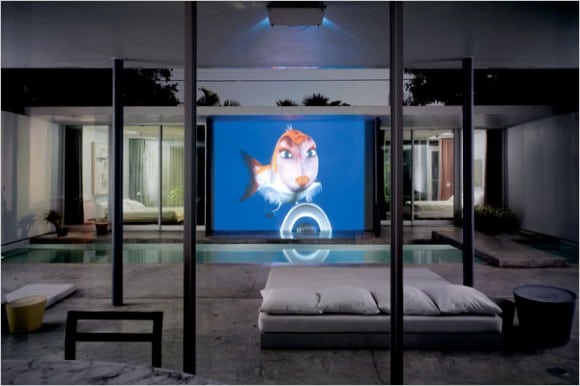Off the Wall Take away the artwork and you take away the architecture. This is true of Terence Riley and John Bennett’s Miami house — in theory, at least. Riley, who is the director of the Miami Art Museum (and the former chief curator of architecture and design at the Museum of Modern Art in New York), and Bennett, who is an architect, designed their house on Miesian principles. They were particularly inspired by Ludwig Mies van der Rohe drawings of unrealized ‘‘court houses,’’ which indicated where an entire wall would become, say, a Georges Braque painting. ‘‘Certainly the use of digital technology to turn the wall into art was something Mies could not have guessed,’’ Riley says. Their approach may sound rigorously academic, but the video setup, like the house itself, is actually an informal one: a projector mounted on the terrace ceiling beams images across the interior courtyard onto a stuccoed wall painted bright white. While film is heading to the minute screen — miniaturizing itself onto iPods and cellphones — advances in technology are allowing video installations to assume a scale not seen since the days of the drive-in. (Riley recently oversaw the MAM’s acquisition of Doug Aitken’s video piece ‘‘Sleepwalkers,’’ originally projected, to awesome effect, on the exterior walls of MoMA.) ‘‘We have artist friends who are very excited,’’ Riley says of the possibility of creating site-specific work. In this photo, the protagonist of the artist Matthew Weinstein’s ‘‘Three Love Songs From the Bottom of the Ocean’’ is coyly reflected in the swimming pool. ‘‘But when video art is not there, it’s a great place to watch movies,’’ Riley adds.
- Aziel Jackson – In His Own Words: Making His “FIRST MOVE” in Fashion - Thursday, March 14, 2024
- Miami Dolphins’ Stand-Out Terron Armstead Continues To Win In The Art of Giving-Back - Monday, June 5, 2023
- Delux Feature: Celebrity Barber and Fitness Trainer, Lawrence Roebuck, Shares His Tips for a Healthier Lifestyle During Stress Awareness Month - Monday, May 8, 2023








